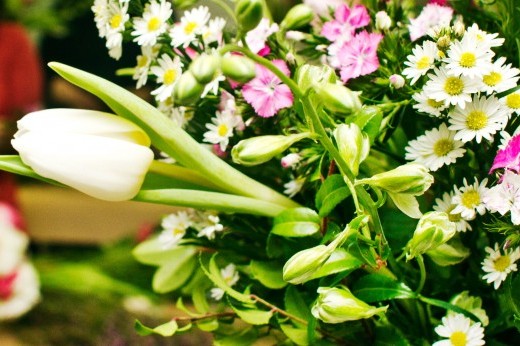It's late spring, early summer. Your garden is in peak bloom, filled with vibrantly colored flowers. And now you've picked up an article urging you to cut those beautiful blossoms. "No, never!" you say. But this is precisely the time to create a stunning bouquet from the fruits of your labor, so you can enjoy the sights and smells of the garden inside your home as well as outside it.
As soon as the plants in my small border garden begin flowering, I begin cutting. I know that it only takes one gusty wind or heavy summer rain to destroy my beloved blooms. Cutting guarantees that at least some of my flowers will be spared this cruel fate.
There is another reason I cut: It encourages more flowering on my plants throughout the summer months and even into early fall. Periodic cutting performs the same function as deadheading—promoting more blooms by delaying the onset of fruit.
Of course, the main reason I cut is for the tremendous satisfaction I get seeing my garden-grown flowers sitting pretty in a vase on the kitchen table. The number of flowers needed depends on the size of the vase used. In order to avoid cutting too many, I add foliage to the arrangement. I use a branch or two from a tree or shrub, or some groundcover with assorted grasses. These materials help me create bouquets of various sizes and shapes.
I make sure to pick and condition my flowers properly, so they'll have an extended vase life. There are many tricks in the cut-flower trade for creating long-lasting displays. Following are some of the best of them.
When to Cut
Early morning is the ideal time to cut fresh flowers. The flowers have had the benefit of cool night air and morning dew. Their stems are filled with water and carbohydrates and so are firm to the touch. As the day warms up, flowers gradually dehydrate. Midday is the least auspicious time to cut, as transpiration rates are at a peak and plants are rapidly losing moisture through their leaves. Flowers become limp; their necks become bent. If cut, they will not recuperate well and their vase life will probably be short.
When harvesting, have a bucket of water on hand to put the flowers in. Don't dillydally; place the cut flowers in the bucket immediately. I like to use a plastic pail rather than a metal one because metal can affect the pH balance of the water.
Different types of flowers must be harvested at appropriate stages in their development. Flowers with multiple buds on each stem should have at least one bud showing color and one bud starting to open before being cut. This is true for spike flowers (salvias, agastaches, delphiniums, Eremurus, gladioli, snapdragons, stocks, larkspurs, and the like) as well as cluster flowers (agapanthus, Alstroemeria, baby's breath, Clarkia, lilacs, phlox, Queen Anne's lace, verbenas, yarrow, and silenes, for example). If gathered too early—while they're still tightly budded—these flowers will not open in a vase of water.
By contrast, flowers that grow on individual stems (such as asters, calendulas, chrysanthemums, dahlias, Datura, gerbera daisies, marigolds, sunflowers, Tithonia, and zinnias) should be cut when fully open.
When selecting foliage, look for firm leaves and stems with strong coloration.
Cutting Tools and Techniques
Always use clean, sharp utensils when cutting flowers. Knives, clippers, or shears can be employed. Never use ordinary household scissors. The gauge on scissors is set for paper or fabric, not for flower stems, which are bulkier. Using scissors will crush their vascular systems and prevent proper water uptake.
Flower and foliage stems that have been left out of water, even for a short period of time, seal up and inhibit the absorption of water. Air bubbles sometimes enter the stem and prevent a steady flow of water. In order to prevent this from happening, some people cut their flowers under water before transferring from bucket to vase. However, I have found this to be awkward. Custom-cutting the flower stem in open air and immediately placing it in the vase of water is usually fine.
More: Making A Midcentury Wedding Bouquet
Cut all flowers and foliage about one inch from the bottom of a main stem. Make the slice at an angle of about 45 degrees. Cutting at an angle provides a larger exposed area for the uptake of water. It also enables the stem to stand on a point, allowing water to be in contact with the cut surface. Remove all the lower foliage that would be submerged in water. This will retard bacterial growth, which shortens the vase life of flowers and makes the water smell foul.
Water Temperature
Professional florists and commercial growers always use lukewarm water for their cut flowers. The water temperature should be 100°F to 110°F. (An exception is when you are using bulb flowers, such as hyacinths and tulips, which need cold water.) Warm water molecules move faster than cold water molecules and so can be absorbed by flowers with greater ease. The objective is to get water and nutrients as quickly as possible to the head of the flower.
Preservatives
Using a preservative definitely increases the longevity of cut flowers. To survive, flowers need three ingredients: carbohydrates, biocides, and acidifiers. Carbohydrates are necessary for cell metabolism; biocides combat bacteria and are necessary for maintaining plant health; acidifiers adjust the pH of water to facilitate and increase water uptake.
Homemade Flower Preservative
Home mixes can be as effective as commercial preservatives. This easy-to-make recipe is my favorite.
- 1 teaspoon sugar
- 1 teaspoon household bleach
- 2 teaspoons lemon or lime juice
- 1 quart lukewarm water
Under normal circumstances, flowers get what they need from the plant. When severed from the plant, however, flowers are deprived of these essential substances. But they are present in ready-made commercial preservatives, like Floral Life. Such solutions contain sugar for nutrition, bleach to keep the water clear of bacteria, and citric acid to gently acidify the water. When using commercial brands, be sure to follow recommended measurements for different container sizes.
One common suggestion is to place an aspirin in the water to keep flowers fresh. It is likely that aspirin's effectiveness is simply the result of the drug's carbohydrate content. Another well-known suggestion is to drop a penny into the water. Apparently, the copper in the penny works like an acidifier, decreasing the pH of the water. Unfortunately, solid copper pennies are no longer being minted.
Preparing the Stems
Garden flowers require some additional preparation after cutting. The type of preparation depends on the type of flower stem: hearty, hollow, soft, woody, or milky.
Hearty Stems
Flowers with hearty (or solid) stems, such as cockscomb, Clarkia, marigolds, statice, and transvaal daisies, need only the diagonal cut to absorb maximum water. They should be left to drink in lukewarm water with preservative for a minimum of one hour before arranging.
Hollow Stems
The stems of hollow-stemmed flowers, such as amaryllis, bells-of-Ireland, dahlias, delphiniums, and hollyhocks, need to be filled with water. Simply turn the flower upside down and pour water into the open cavity of the stalk. To keep the liquid in, you can plug the stem with a small piece of cotton and then place it in the vase. Alternatively, place your thumb over the opening at the bottom of the stem and then put it in the water. The water trapped inside will keep the stem strong and straight. I have noticed that when I fill the hollow stems in this way, the heads of my dahlias stand upright and the small buds on the tip my larkspur actually open!
Soft Stems
Bulb flowers such as hyacinths, iris, and tulips have soft stems and should be cut where the green on the stem starts—just above the white bulb. Place the flowers in cold water. Since most bulbs bloom when the air and ground are still at low temperatures, they do better in a vase of cold water.
Woody Stems
For woody plants such as lilac, dogwood, mock orange, pear, and heather, be sure to split the stems at the ends rather than smash them. This will keep vascular tissues intact and create more surface area to absorb water.
Milky Stems
Flowers such as euphorbia, lobelia, poinsettia, and snow-on-the-mountain secrete latex sap that oozes into the water and clogs the vascular system of other flowers in the container, preventing them from absorbing water. For this reason, the ends of the stems need to be seared before the flowers are placed in the arrangement. There are two ways to accomplish this: Either dip the cut end of the flower in boiling water for 30 seconds or apply a flame from a match or candle to the precut flower stem for about 30 seconds.
Do not use these flowers with a pin holder, because each time the flowers are cut they need to be seared again. Searing is not effective in halting the seepage of secretion from daffodils. Therefore daffodils should not be mixed with other flowers if you want a long-lasting arrangement.
Designing the Arrangement
Now that the flowers you have taken from your garden are conditioned, it's time to create an arrangement. Here are three design tips used by professionals:
- The height of the flowers should be in proportion to the size of the container—that is, the height of the flowers should not exceed one and a half times the height of the container.
- The arrangement should appear uniform all around. Visualize a circle divided into three equal sectors, and then select similar flowers for each of the sectors.
- Support the flowers to keep them in place. One simple approach, which avoids the use of props, is to use the flower stems themselves for support. By placing each flower into the container at an angle, you can form a grid or web that will hold the design together. The only flower that should be inserted straight up in the container is the center flower. This flower cannot stand without the support of the other flowers and should be placed in the container only when the grid has taken shape.
Care of Cut Flowers in an Arrangement
Here are some general rules that will help you make your cut-flower arrangements last:
- Don't overcrowd the flowers in the container.
- Check the water level in the vase and replenish it frequently.
- Flowers that go limp are not drinking well and need to be recut.
- Always discard wilted blooms.
- Keep flowers away from drafts, direct sunlight, and ripening fruits, which emit ethylene gas—a substance that causes buds to remain closed, petals to have poor color, and flowers to have a shortened vase life.



